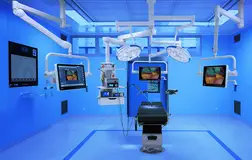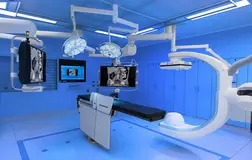New Construction Project: KARL STORZ Equips 16 Operating Rooms at Heidelberg University Hospital for Surgery
18/11/2020
Tuttlingen, 18.11.2020: Following an invitation to tender, the endoscopy and integration specialist KARL STORZ was awarded a contract in June 2017 to plan and implement the operating rooms in the new building of the Heidelberg University Hospital for Surgery using state-of-the-art integration solutions. In context of the tender process, the University Hospital aimed to use not only solutions commonly found on the market, but to also integrate new and innovative systems, which were to be developed in collaboration with strong, expert partners and optimized for everyday clinical practice over the course of the project. Prof. Dr. Markus Hohenfellner, Medical Director of the Department of Urology, explained the hospital's commitment to innovation as follows: “We are setting new standards with the new building for the Heidelberg University Hospital for Surgery. Now, having completed an extensive planning and construction phase, we are particularly proud to have one of Germany’s most cutting-edge surgical wards up and running.”
The new Hospital for Surgery commenced operations on October 10, 2020. As home to a total of six specialty departments within a space some 21,000 m² in size, it ensures excellent medical care for patients. At the heart of the Hospital for Surgery lies the surgical ward, whose 16 operating rooms are integrated into the hospital’s medical and IT landscape through the innovative KARL STORZ OR1™ system. “The technologies and software solutions employed provide unparalleled, innovative support of processes in and around the operating room,” noted Prof. Dr. Dr. h.C Markus W. Büchler, Center Spokesperson for the University Hospital for Surgery.
To complement the OR1™ integration solution (which offers completely networked audiovisual management, documentation, and communication within and outside the operating room) the project’s innovation segment aimed, among other things, at supporting effective clinical workflows through innovative software tools. Special attention was paid to semiautomated processes and comprehensive content management across the various systems.
“We deliberately included an innovation segment in the invitation to tender, in order to ensure that, from the very start of clinical operations, we will immediately have future-oriented solutions at our disposal. We broke new ground with this project, and together with the experience, creativity, and innovative strength of KARL STORZ, we as a university hospital have developed a cutting-edge solution in terms of both classic integration issues and new software applications,” commented Dr. med. Hannes Götz Kenngott, surgeon and project representative for Heidelberg University Hospital, on their collaboration with project partner KARL STORZ.
The interdisciplinary project team consisted of KARL STORZ software and integration experts as well as university hospital employees; among other things, it placed particular focus on smart data systems. The team tasked itself with developing systems that employ device parameters to control OR management tasks (such as visualizing patient status or creating and changing surgical schedules), while also maintaining data security. Productive solution approaches included dashboard applications for centralized data provision and flexible-use monitors that could serve as both observation monitors and user interfaces for integrated devices.
“KARL STORZ development engineers worked hand-in-hand with clinical users on this project. As a result, we were in a position to incorporate research and development expertise directly into new products and systems, thereby ensuring optimal workflow from the idea to development and market launch. For both the hospital and KARL STORZ, the installed solutions represent promising product innovations that will soon be available to all customers,” remarked Simon Holzer, Director Strategic Key Accounts & Software Sales Global OR1™ at KARL STORZ. “One notable aspect of the project timeline was that we were able to install a preliminary test version in the University Hospital’s so-called experimental OR. This allowed us to conduct real-time testing of the technology, system interactions, and usability aspects, and to optimize them further in response to direct user feedback. A win-win situation that ensured high user acceptance of the new systems from the very start of the project.”
Prof. Dr. Hohenfellner explained the close ties between research and clinical implementation: “To develop new digital solutions, we also collaborate on research projects, like the recently completed OP4.1 project. A follow-up application, taking the completed projects into account, has already been submitted. These projects focused on integrating various process- and patient-related data in order to provide the different stakeholders in the operating environment with the data relevant to them at exactly the right time.”


